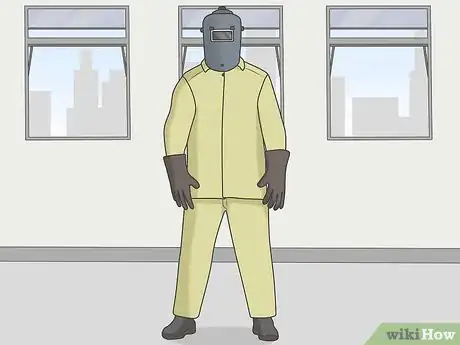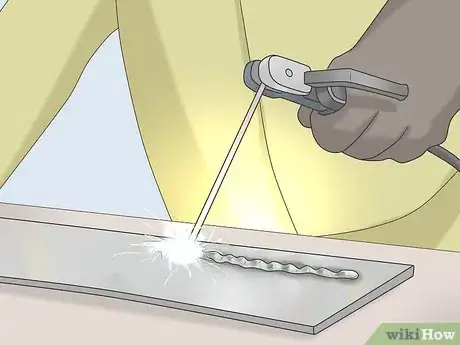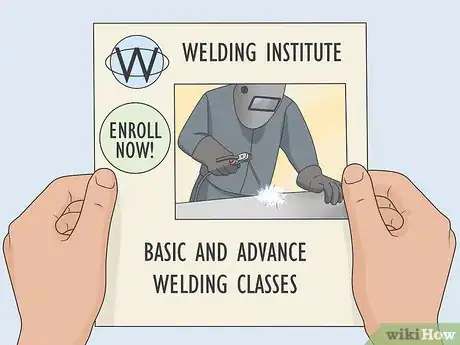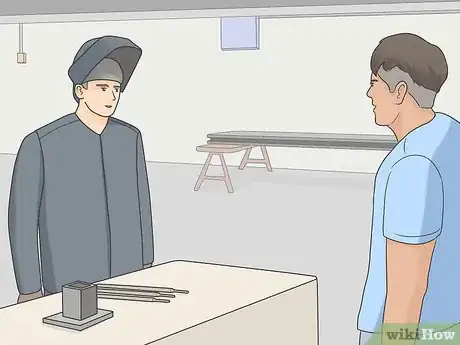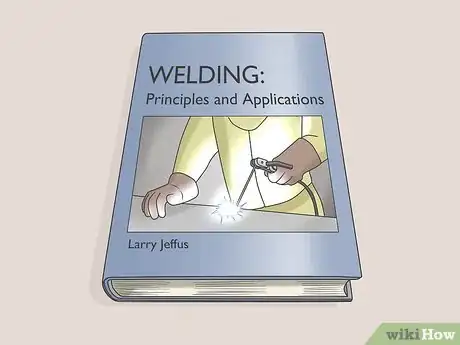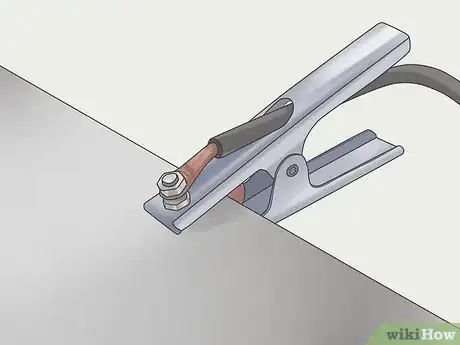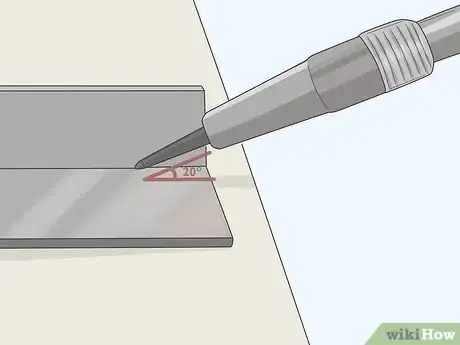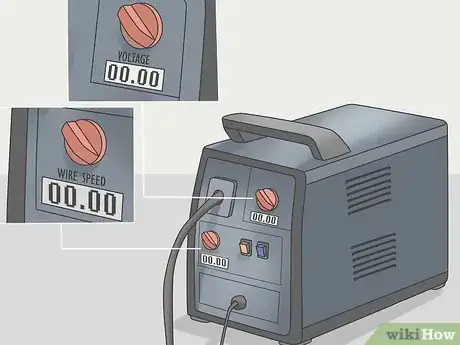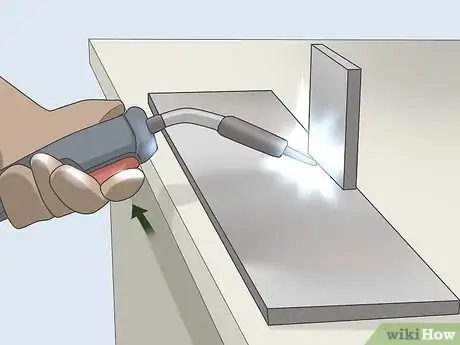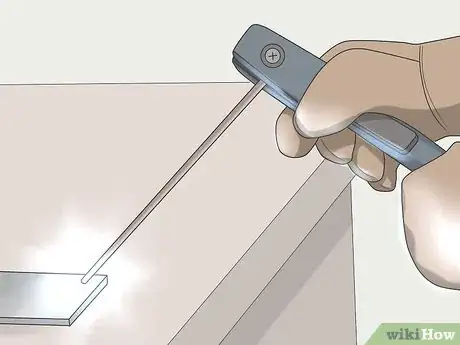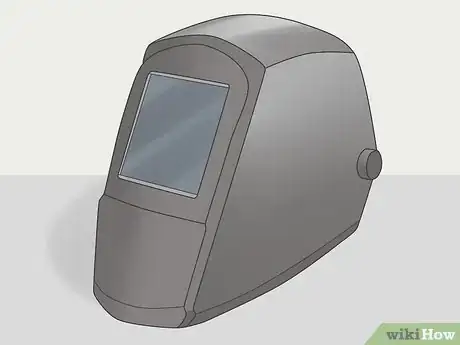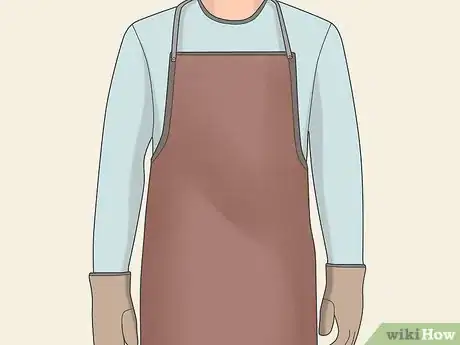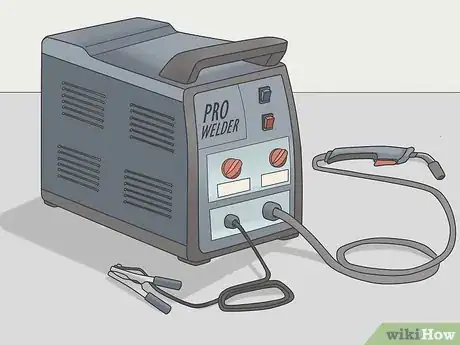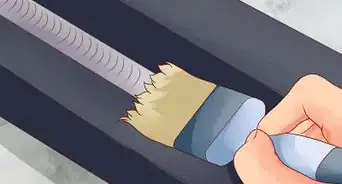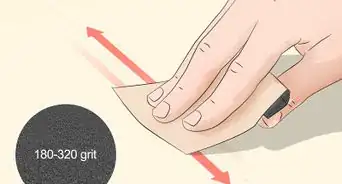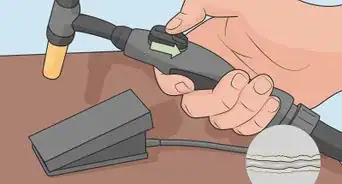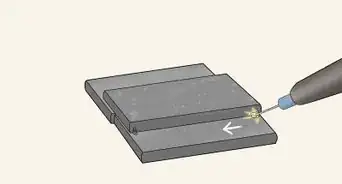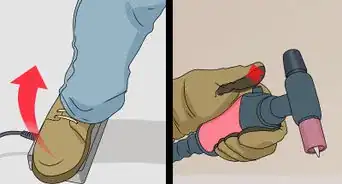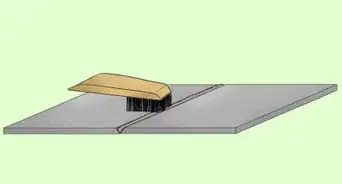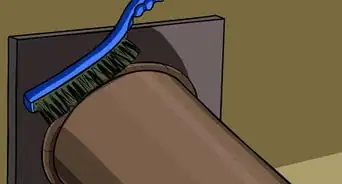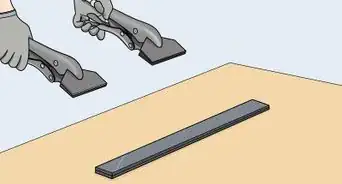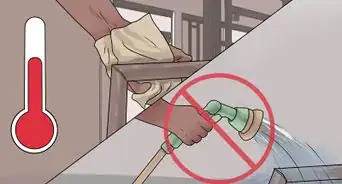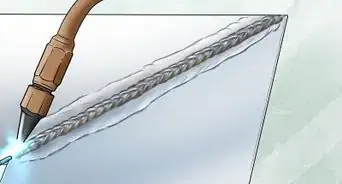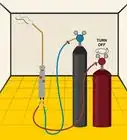This article was co-authored by wikiHow Staff. Our trained team of editors and researchers validate articles for accuracy and comprehensiveness. wikiHow's Content Management Team carefully monitors the work from our editorial staff to ensure that each article is backed by trusted research and meets our high quality standards.
There are 16 references cited in this article, which can be found at the bottom of the page.
wikiHow marks an article as reader-approved once it receives enough positive feedback. This article received 15 testimonials and 95% of readers who voted found it helpful, earning it our reader-approved status.
This article has been viewed 492,970 times.
Learn more...
Welding is the process of superheating and connecting pieces of metal together. While it's a necessary skill for anyone in metalworking, it can also be an incredibly fun and creative hobby. You can use welding to construct art projects or to fix things around the house. Before you go out and purchase your first welding machine, it's important that you do your research and know exactly what you're doing. Reading and watching videos online may show you the basics, but the safest and most effective way to learn is by taking a class or speaking to an experienced professional welder.
Steps
Learning How to Weld
-
1Work in a well-ventilated area and wear safety gear. Inhaling the noxious fumes from certain welding machines is dangerous and unhealthy. Open windows and doors to make sure that the room is well-ventilated. In addition, make sure to wear all safety gear before you start welding.[1]
-
2Decide on which style of welding you want to do. If you took a course or class, then you should stick with the welding technique and machine that you’ve already used. If you’ve practiced using a variety of methods, choose the method you like best. The 2 most common methods for beginners are gas metal arc welding (MIG) and arc welding, also referred to as stick welding.[2]
- Stick and MIG welding equipment is cheaper and easier to learn than other methods.
- TIG welding, otherwise known as gas tungsten arc welding (GTAW), and flux-cored welding, are more complex forms of welding that should be avoided if you’re a beginner.
Advertisement -
3Practice welding on scrap metal before you work on a real project. Practice creating “beads” or welds on pieces of scrap metal before trying to weld 2 pieces of metal together for an actual project. This will get you more acclimated to using the welding machine and will help you achieve straighter welds.[3]
-
4Look for welding classes at community and art centers. Search online or on your local community's or art center’s website to see if there are any introductory welding classes available. These courses will already have a workshop and equipment set up for you, so you don’t have to purchase it yourself, and will provide introductory instruction that can help you get started on your welding hobby.[4]
- These courses can range anywhere from a day of training to 2-3 months of training.
- Ask for a class schedule before you sign up for the classes.
-
5Contact a community college to see if they offer welding classes. Many community colleges, vocational schools, and some universities offer welding classes as part of their curriculum. If you are going to school or plan on going to school, search on the school’s website to see if they offer welding classes. Then, sign up for the class during your class registration period.[5]
- You don’t have to be a student to take a welding-specific class at certain community colleges and vocational schools. Call the college and ask them to find out.
-
6Speak to local welders in your area if you can’t sign up for a class. If no community centers or schools offer welding classes, or you can’t afford them, local welders may be willing to show you the ropes. Search for welding or metal fabrication companies near you and then call them and tell them that you’re interested in touring their workshop. Arrange a time and date to visit them, then express your interest while taking the tour.[6]
- Welding and metal fabrication companies will often offer tours for free.
- If you want to learn how to weld, ask metal fabricators if you can apprentice or work as a fellow under them
- Seeing welding in person will give you a better idea of whether it’s the hobby for you.
-
7Watch video tutorials online to learn common welding techniques. You can use YouTube to provide supplemental knowledge for the classes that you’re taking or to learn different welding techniques. Because welding can be dangerous, you should practice under the supervision of an experienced welder before you start doing it yourself.[7]
-
8Read articles and books on how to weld. You can visit the American Welding Society’s website to read articles and publications on welding. Popular welding books include Welding: Principles and Applications by Larry Jeffus, Audel Welding Pocket Reference by James E. Brumbaugh and Rex Miller, and Welding Essentials by William L. Galvery Jr. and Frank B. Marlow, just to name a few. If you want to enhance your knowledge of different welding practices and techniques, read these books and articles.
Performing Welding Basics
-
1Attach the welder's ground clamp to your workstation. It's important to ground the welder or you may electrocute yourself as you weld. The ground clamp should be attached to a flexible hose coming from your welder. Attach the clamp to the table or workstation that you plan on welding on.[8]
-
2Position the tip of the gun at a 20-degree angle as you weld. Always hold your welding gun with 2 hands. Position the tip of the gun towards the metal, at a 20-degree angle so that you can push the weld away from you.[9]
- Remember to wear your welding gloves.
-
3Move your gun in tiny circles as you weld to create a bead. A bead is the proper weld shape and looks like tiny circles when you're done. When you practice welding, make these tiny circles to create a bead instead of pushing the welding gun in a straight line.[10]
Learning the Basics of MIG Welding
-
1Set up your MIG welder properly. Check the tubes and wires attached to the welder and make sure that they are in good condition. Check the MIG welding gun's trigger and make sure that there is a wire properly feeding out of the tip of the gun. Ensure that your shielding gas canisters are attached to the machine and are properly set up.[11]
-
2Adjust the wire speed and voltage to make a consistent weld. Your wire speed setting is determined by your machine, the type of wire you are using, and the thickness of the metal that you're welding. Adjust the wire speed and voltage so that the weld is clean. You'll know you're welding a proper bead when it sounds like a consistent sizzle similar to bacon. If your weld cracks and spurts, you have to adjust your settings.[12]
- A slower wire speed works better on thinner pieces of metal.
- Getting the perfect settings for your work area and materials is usually up to trial and error.
-
3Press the trigger on the gun's handle to start welding. Pushing the trigger will feed the wire through the machine at a regulated rate and create the weld. As you weld, make sure that you move slowly in small circular motions over the metal.[13]
- If you notice that the welding machine isn't working properly, adjust the settings.
Learning Stick Welding Basics
-
1Set the welding machine to DC positive polarity. Direct current, or DC positive, allows for a greater level of penetration than alternating current, or AC, polarity. This makes it easier for first-time welders to create a uniform bead as they begin to weld.[14]
-
2Set the amperage to the same level as the stick you're using. The stick that attaches to your welding gun is an electrode and is often referred to as the "rod." Different rods will have specifications found on their packaging or in their instruction manuals that explain the proper corresponding amperage that your machine needs.[15]
-
3Tap your rod against metal to start it up. The electrode should be tightened in the welding gun before you start. Lightly strike the rod against the metal like a match to start the weld. When it successfully starts welding, you'll see an electric arc coming from the electrode on your gun.[16]
- Remember to wear a non-flammable apron, welding mask, and gloves before you weld.
Getting Your Welding Equipment
-
1Purchase an auto-darkening welding helmet. The light that welding gives off is incredibly bright and can cause permanent damage to your eyesight. In addition to protecting your eyes, a full-face welding helmet will prevent sparks and metal debris from being shot into your face as you weld. You should never weld a piece of metal without having full face and eye protection first.[17]
- An auto-darkening welding helmet will prevent you from having to lift up your helmet when you stop welding.
-
2Get heavy-duty welding gloves. Thick leather welding gloves will protect your hands from getting burnt while you weld. Before you purchase welding gloves, determine the kind of welding you want to do, then purchase gloves made specifically for that style. This information is typically found in the product description or within the name of the product itself.[18]
- For instance, MIG welding gloves are often thicker and provide less hand mobility than TIG welding gloves.
-
3Wear a thick leather apron and a long-sleeved shirt when welding. Buy a leather apron that’s made for welding will protect your clothes and body from getting burned. Under your apron, you should wear a long-sleeved shirt with buttoned or closed cuffs, long pants, and closed toe shoes or boots.[19]
-
4Buy a welding machine that falls within your budget and needs. Search online for different welding machines and read customer reviews to find a reliable brand and model that you can purchase. Stick welders are typically the cheapest, while MIG welders are more expensive on average. Once you determine which machine you want, order it online or from a hardware store and bring it to your working area.
- The average stick welder will be anywhere from $75 - $400 USD.
- MIG welders typically cost anywhere from $100 - $1,000 USD.
Community Q&A
-
QuestionIs welding a good hobby?
 wikiHow Staff EditorThis answer was written by one of our trained team of researchers who validated it for accuracy and comprehensiveness.
wikiHow Staff EditorThis answer was written by one of our trained team of researchers who validated it for accuracy and comprehensiveness.
Staff Answer wikiHow Staff EditorStaff AnswerWelding is a great hobby if you enjoy DIY projects! It’s also a great way to save money on home and auto repairs that you’d normally have to pay a professional to do.
wikiHow Staff EditorStaff AnswerWelding is a great hobby if you enjoy DIY projects! It’s also a great way to save money on home and auto repairs that you’d normally have to pay a professional to do. -
QuestionCan you teach yourself welding?
 wikiHow Staff EditorThis answer was written by one of our trained team of researchers who validated it for accuracy and comprehensiveness.
wikiHow Staff EditorThis answer was written by one of our trained team of researchers who validated it for accuracy and comprehensiveness.
Staff Answer wikiHow Staff EditorStaff AnswerYes, but you’ll want to start with a relatively easy method, like MIG welding. It’s a good idea to at least get advice from an experienced welder about the best kinds of equipment and protective gear to buy, and how to use it all safely.
wikiHow Staff EditorStaff AnswerYes, but you’ll want to start with a relatively easy method, like MIG welding. It’s a good idea to at least get advice from an experienced welder about the best kinds of equipment and protective gear to buy, and how to use it all safely. -
QuestionWhat is the easiest type of welding to learn?
 wikiHow Staff EditorThis answer was written by one of our trained team of researchers who validated it for accuracy and comprehensiveness.
wikiHow Staff EditorThis answer was written by one of our trained team of researchers who validated it for accuracy and comprehensiveness.
Staff Answer wikiHow Staff EditorStaff AnswerMIG welding is probably the easiest. It’s easy to preset the speed of the weld and how much gas and heat you use, so you don’t have to worry about controlling those factors while you’re welding. It’s not as clean as some other methods, like TIG welding, however.
wikiHow Staff EditorStaff AnswerMIG welding is probably the easiest. It’s easy to preset the speed of the weld and how much gas and heat you use, so you don’t have to worry about controlling those factors while you’re welding. It’s not as clean as some other methods, like TIG welding, however.
References
- ↑ https://www.ccohs.ca/oshanswers/safety_haz/welding/ventilation.html
- ↑ http://modernwelding.net/hobby-welding/
- ↑ https://youtu.be/8veisgOaHUg?t=1m58s
- ↑ http://www.hobbyfarms.com/learning-to-weld/
- ↑ https://www.gowelding.org/welding-schools/
- ↑ http://modernwelding.net/hobby-welding/
- ↑ https://youtu.be/8veisgOaHUg?t=1m25s
- ↑ http://www.weldingtipsandtricks.com/how-to-mig-weld.html
- ↑ http://www.mig-welding.co.uk/learning-mig.htm
- ↑ https://www.youtube.com/watch?v=jtlOOOTpZYM&feature=youtu.be&t=1m34s
- ↑ https://youtu.be/hgGG-ifphkA?t=10m36s
- ↑ https://youtu.be/_f54YG08CC4?t=4m33s
- ↑ http://www.mig-welding.co.uk/learning-mig.htm
- ↑ http://weldingproductivity.com/article/ac-vs-dc/
- ↑ https://www.realworldsurvivor.com/2015/01/16/welding-workshop-stick-welding-beginners/#tim-reed-04
- ↑ https://www.realworldsurvivor.com/2015/01/16/welding-workshop-stick-welding-beginners/#tim-reed-04
- ↑ http://www.usaweld.com/Learn-How-to-MIG-Weld-s/416.htm
- ↑ http://www.globalspec.com/learnmore/manufacturing_process_equipment/safety_personal_protective_equipment/welding_gloves
- ↑ https://www.ccohs.ca/oshanswers/safety_haz/welding/ppe.html
About This Article
If you want to learn how to weld as a hobby, decide what kind of welding you'd like to do. Stick and MIG welding are cheaper and easier for beginners than TIG welding. Then, search online to see if there are welding classes offered at any local colleges or community centers. If you can, enroll in a welding class. If you can't, ask local welders if they will teach you or find tutorials online and read articles about welding. To start welding, you'll need to purchase or borrow protective clothing and a mask. To learn the basics of stick and MIG welding, keep reading!
